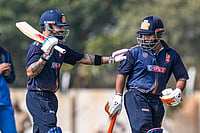The stories linger in your mind like the ineffable sweetness of wild honey. You do not taste them on your tongue. You dribble them slowly, squeezing the drops, licking your fingers and palms, marvelling at the texture and taste of the waxen honeycomb, while flicking out the occasional black ant or dead fly.
Sundara Ramaswamy (1931-2005), or Su-Ra to admirers, was a doyen in Tamil literature. Playwright, novelist, literary critic as well as editor of a literary magazine, Kalachavudu, he was equally at home writing poetry, or short stories with a hallucinatory edge. The Tamarind Tree (1966), his first novel, translated by S. Krishnan, and J.J. Some Jottings (1981), translated by A.R. Venkatachalapathy for Katha in 2004, have a cult following.
Lakshmi Holmstrom has been able to blend herself into the texture of the author’s world so as to seem to actually enhance it. Not an easy task. Ramaswamy himself has been depicted as “half-knowing Malayalam, Sanskrit and English” and learning Tamil only in his late teens. Like the little boy, Balu, in his novel, he may well have been a late learner, losing himself as Balu does in an intense preoccupation with the world around him. It cannot be accidental that the title of the novel is Children, Women, Men.
As in poet A.K. Ramanujan’s delineation of the different worlds inhabited by his characters, Ramaswamy’s families exist in separate compartments, as it were, of their bodies and their minds. The interior landscape of the women is as alien as that of the outward-seeming terrain of the men. The children inhabit a delicately rendered space in between them—as invisible guardians of family secrets as well as possible catalysts of change, particularly in the case of the young girls, who are both cherished as prizes as well as items to be bartered in such traditional societies. It is into this labyrinth of social engineering that Ramaswamy introduces rumours of an extraordinary individual named Gandhi.
True, there are resonances of all sorts everywhere. Raja Rao’s Kanthapura, set in a similarly repressive village in Mysore, and Attia Hosain’s Sunlight on a Broken Pillar, on individual awakening in an old, settled society, come to mind. Su-Ra plunges us into a world of such exquisite clarity as to seem Kurosawaesque in its charm. Even if its grotesque inequalities are noticed—though not necessarily derided, in a Mulk Raj Anand swipe of disgust. It is a society that seems almost alien from us and yet as the proliferation of sexual assaults on young women, the clamour of caste- and communal-based politics get more strident, Ramaswamy’s unresolved questions are a reminder of how much further we must travel.
Lakshmi Holmstrom’s introduction to the volume of short stories serves as an important starting point to those who are not familiar with the Ramaswamy milieu. Do we need to care about a small Brahmin community living, as many of his early characters do, in the in-between times just before Independence and in the in-between towns bordering what are now Kerala and Tamil Nadu?
Holmstrom sets us right. “Critics,” she writes, “have placed him among the great innovatory writers in modern Tamil, along with Bharathi, Pudhumaipithan, Mouni and La Sa Ramamritham. They have praised, in particular, his powers of description and his handling of complex powerful emotions and metaphysical notions in easy and accessible prose...but above all, his gift lies in his handling of colloquial language, of creating characters through speech.” She might have added also a word about his essential humanism. The first books that Ramaswamy himself translated was Thakazhi Sivasankara Pillai’s Chemmeen and The Scavenger’s Son. Though his characters inhabit the seemingly secure and inviolable world of the upper-caste Iyer Brahmin community of their time, Ramaswamy’s own imagination, like that of the little Balu and his mentor Laccham in his novel, ranges with the freedom of the kite that Laccham brings to the house. The kite itself, let it be said, has a small vignette that will appeal to followers of Tamil cinematic folklore. For at the very tip of the kite, Laccham has affixed a tiny portrait of the famous child heroine of those times—Baby Saroja, still alive and radiant in her old age at Chennai.
The two books that Penguin Modern Classics has now issued will finally allow Ramaswamy the readership that he so undoubtedly deserves.


























